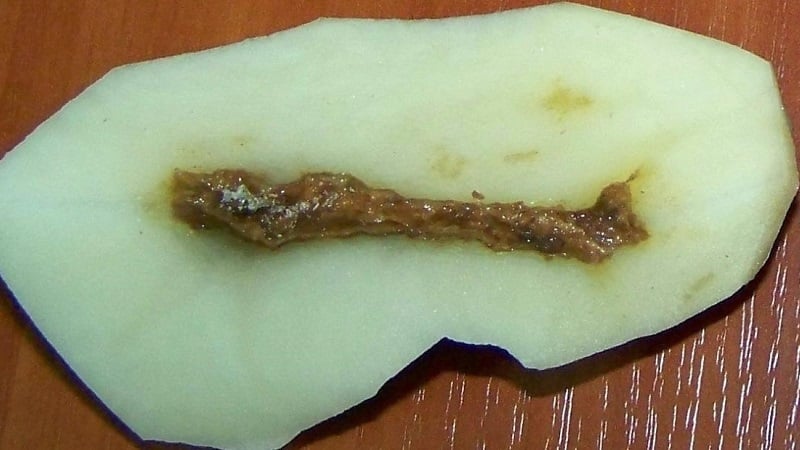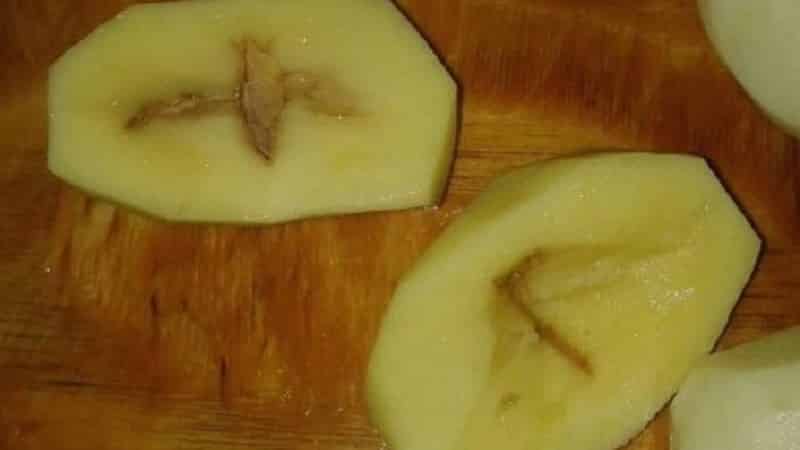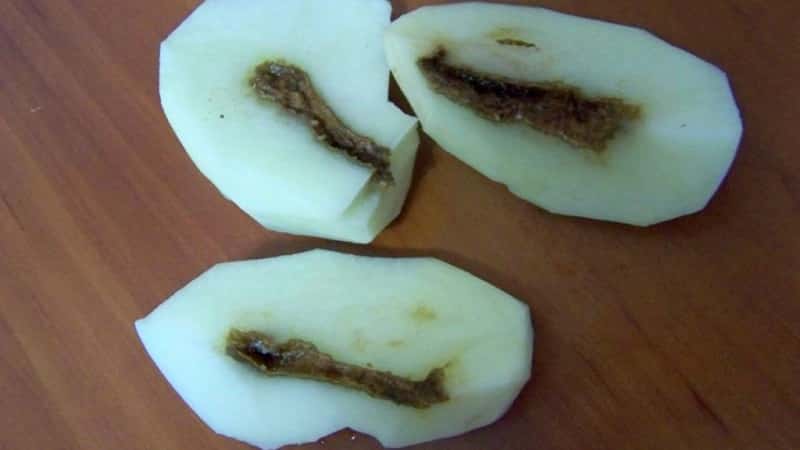What to do if the potatoes inside become empty and why this happens
The formation of voids in tubers depends on the variety, growing conditions, harvesting technology and storage method. Hollowness is not considered a disease and occurs when planting care is not taken care of. Such tubers can be eaten.
Hollowness with blackening, depressed spots are formed due to infectious diseases. Affected tubers are removed from storage and destroyed. In this article we will talk in detail about the reasons for emptiness in potatoes.
What is potato tuber hollowness?
A hollow forms in the core of the potato. In varieties with round tubers it has an elongated or star-shaped shape, in varieties with oblong tubers it has a round or oval shape..
The cavity is covered with a thin skin of cream or light brown color. If the hollow has cracks or branches extending to the surface, the tuber rots.

Signs of infectious diseases that potatoes received during the growth period, – depressed spots on the peel. Subsequently, voids form at the site of the lesion.
Why are the potatoes empty inside?
Voids appear as a result of diseases - non-infectious, bacterial and fungal. Hollowness develops due to improper agricultural practices.
Hollowness
A physiological disease that manifests itself due to improper care. Voids of various sizes and shapes are formed as a result of the growth of internal tissues lagging behind the integumentary tissues.
Metabolic processes are disrupted, starch grains are destroyed, cells die - as a result, cavities are formed. The voids are covered with suberized tissue - a dense skin of cream or beige color.
Why do potatoes become empty inside?:
- Uneven supply of moisture - after a long drought there is heavy rain.
- Changes in air and soil temperature.
- Excess nitrogen fertilizers.
- Boron deficiency in the soil. Tubers in calcareous soddy-podzolic soils especially suffer from a lack of boron.
- The application of high doses of potassium fertilizers results in an increase in the potato's need for boron.
Hollowness is most often observed in large-tuber varieties. Such varieties as Yavor and Gatchinsky are prone to the formation of cavities.
Interesting things on the site:
Why do potato tubers become crumbly when cooked?
Hollowness with blackening
Dry rot of tubers develops as a result of damage by Fusarium wilt.. The disease reaches its maximum value towards the end of storage. The pathogen enters the tuber from the stolon side. First, slightly depressed gray-brown dull spots appear on the surface. Then the peel wrinkles, the flesh becomes dry and rotten.
Subsequently, voids filled with mycelium form in the affected area. The disease quickly spreads from affected tubers to healthy ones. The main source of infection is contaminated soil.
Phoma affects tubers during storage. Depressed dark spots 2-5 cm in size appear on the surface. Voids with a gray or black coating form in the pulp.The source of infection is infected tubers and plant residues in the soil.

Potatoes are empty and brown
Fall armyworm damages potatoes. The caterpillar, 50 mm in size, light gray in color with two stripes on the body, gnaws cavities in the tubers, along the edges of which remnants of the peel can be seen.
Yellow-white hairy beetle larvae eat holes in tuberswithout leaving any skin around the edges. Subsequently, the potatoes rot.
The common mole cricket lives in damp lowlands. It eats away cavities in potatoes, which leads to rotting of the tubers.
Fusarium-bacterial rot appears during storage. May occur as dry rot. Inside the tuber, voids are formed, covered with white, pink or orange mycelium. Sick potatoes have no smell.
Potato ditylenchosis is determined by depressed dark spots in the form of dry rot on the peel. During storage, they increase in size, the tubers crack and dry out. The disease is caused by potato stem nematode. Infection occurs in the soil during the growing season.
Blackleg - the pathogen penetrates the potato through the stolons at the initial stages of tuberization. A colorless spot appears, which gradually softens. The affected area grows, a cavity forms, and the area is limited by a dark line. Rot has a wine smell at first, then a sharp fishy smell. During storage, the core of the tuber is affected, which then becomes hollow and black with a layer of sticky secretions.
Is it worth storing hollow potatoes?
Holiness is revealed only when cutting the tubers. These potatoes are stored until the next harvest. If putrefactive bacteria penetrate the hollow, the potatoes rot.They continue to grow the variety they like, selecting tubers the size of a chicken egg for planting.
Important! Potatoes affected by dangerous infectious diseases are destroyed. During storage, the disease develops due to tubers infected during the growing season.
What to do if the potatoes inside become empty
Large, impeccable-looking potatoes with a suberized cavity are edible.
Tubers with signs of infectious diseases are destroyedto avoid contaminating healthy potatoes during storage.
Take note:
Prevention of potato hollowness
Before storing, the tubers are dried.

Measures to prevent hollowness:
- Maintaining crop rotation.
- Destruction of plant residues after weeding and tops after harvesting potatoes.
- Timely pre-harvest removal of tops.
- The correct ratio of nutrients - potassium, phosphorus and nitrogen. Avoid excessive application of nitrogen fertilizer.
- On richly fertilized soils, plantings are thickened to reduce the area where plants feed.
- Carefully sorting the potatoes before storing them.
The source of boron is organic fertilizers: pig, horse and cattle manure. Poultry droppings do not contain enough boron.
The proportion of nitrogenous fertilizers should be approximately 1.5 times lower than the doses of phosphorus and potassium.
The average need for mineral fertilizers per 1 hundred square meters is:
- nitrogen – 0.6 kg;
- phosphorus – 0.9 kg;
- potassium – 1-1.2 kg.
Potatoes are planted in well-warmed soil. On heavy soils, tubers are planted to a depth of 5-8 cm, on light soils - 8-12 cm.To prevent the formation of a hollow due to temperature changes, cover or hill up during return frosts.
To prevent infections, seed potatoes are sprayed with Fitosporin-M before planting. with stirring. The consumption rate per 100 kg of tubers is 0.4-0.5 liters of the drug, diluted in 6-7 liters of water.
Before laying, spray with the preparation “Maxim” - 0.2 l / 2 l of water. During storage, potatoes are inspected and affected tubers are discarded.
Preparing the storage:
- thoroughly cleaned of debris and old potatoes;
- before laying, the room is treated with bleach (3%) or copper sulfate solution (5%);
- maintain the temperature at +2…+7°C;
- provide ventilation to reduce relative humidity.
Infectious diseases spread quickly at high humidity in the storage.
Conclusion
Now you know why potatoes appear black and empty. Do not leave ripe tubers in the soil for too long. Timely digging prevents the formation of hollows. If the tops show signs of disease, they are mowed down immediately.
Storing the potato harvest is the most important stage in the process of plant cultivation. The size and quality of the future harvest largely depends on the storage conditions of seed potatoes.